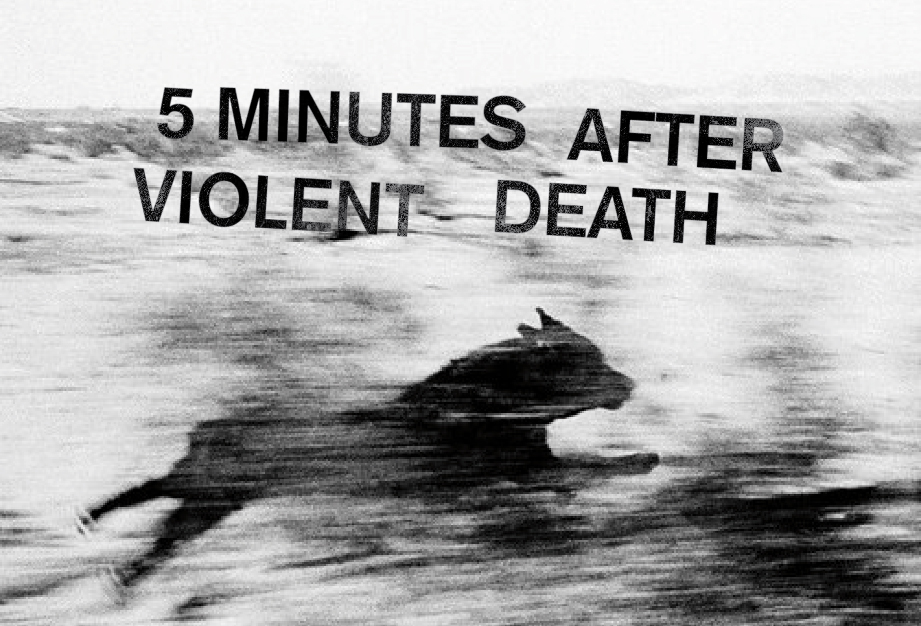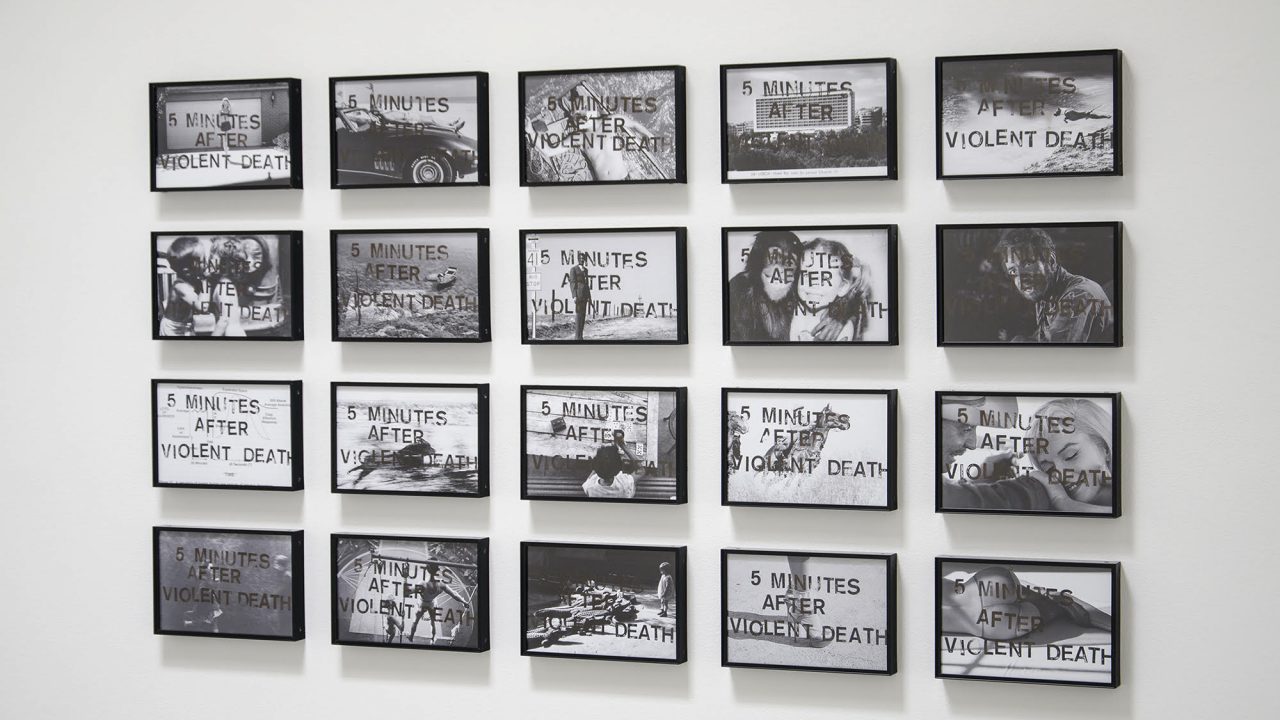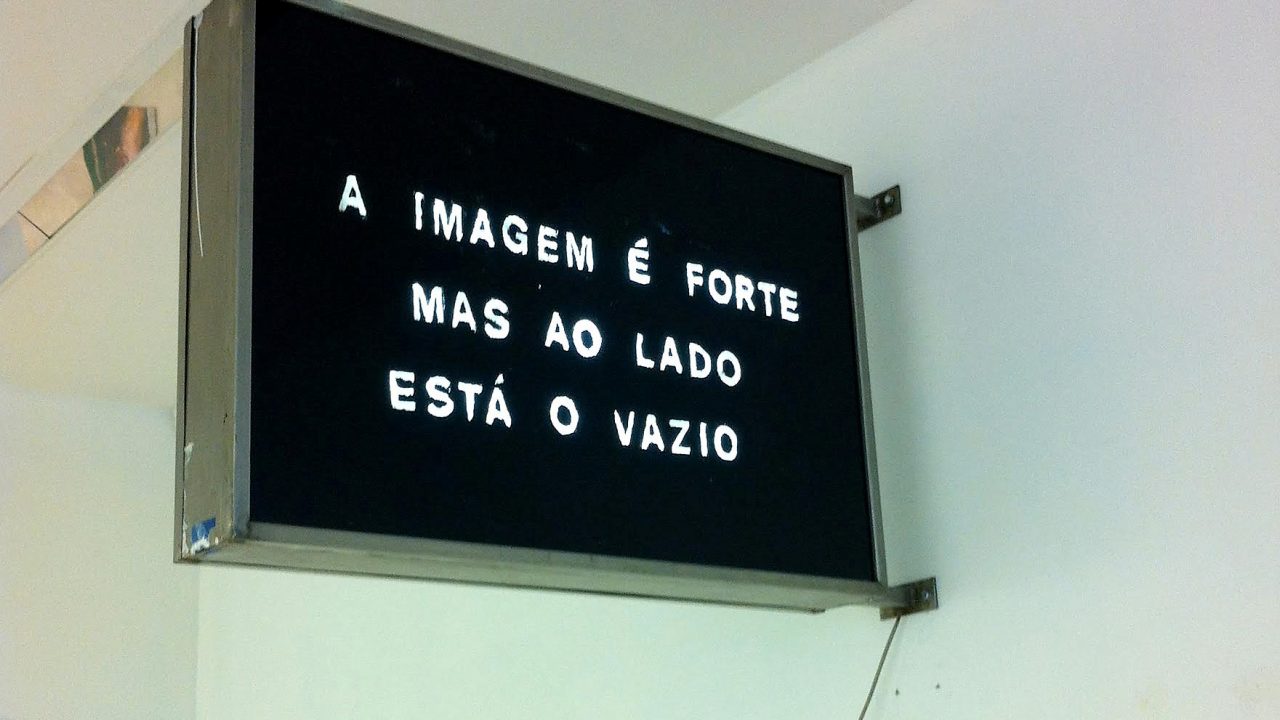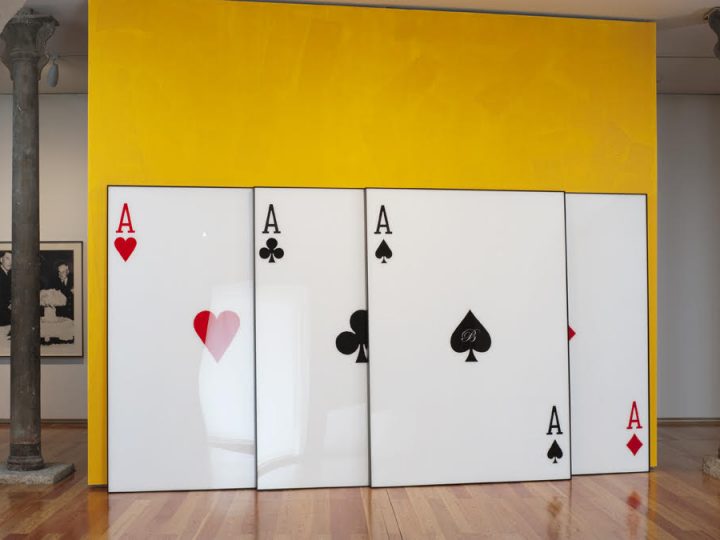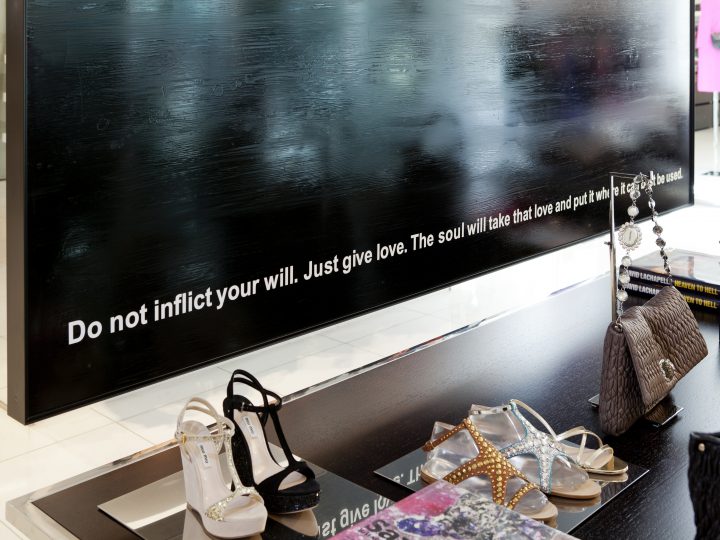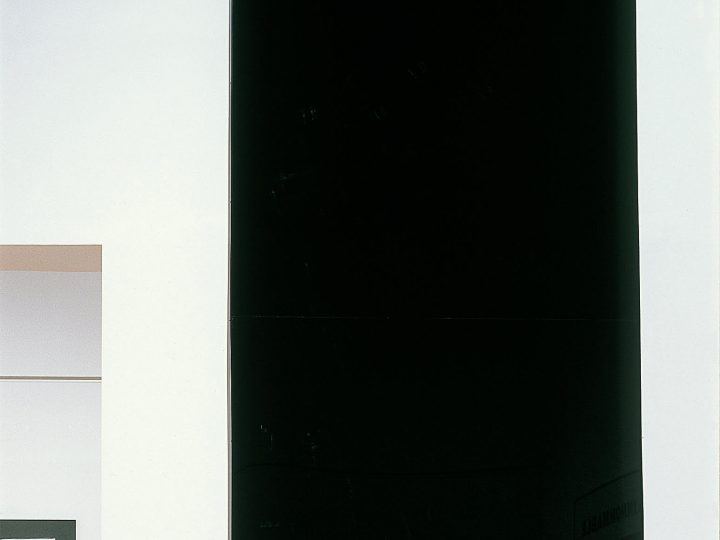THE MOST IMPROBABLE OF THE FACES
Cristina Cachola
2014
in 5 Minutes After Violent Death
There is an aporia that runs through João Louro’s body of work: the one of the insoluble sociability between the image’s presence and absence. An aporia, as we know, constitutes itself as insuperable logical difficulty, problem, impasse, doubt, hindrance of proceed. Literally, from the ancient Greek a+poros, without a way out. (It is not by any chance that one of the artist series has the title Dead End’s). the simultaneousness of the image’s presence and absence (usually of the same image) produces, by its aporetical condition, a matter and form indetermination, making the artwork to be, at the same time, artwork in act and artwork in potency. This way, each artwork extends itself beyond its materiality as it is endowed of an insoluble exterior ontology, that transforms it in a infinite possibilities’ field.
It is not established, therefore, between this two existing ways – presence and absence – a contrasting relation or an antinomy one, not even its (apparent) opposition results of an structuralist operation, in the sense that the two elements act as strategy, containing, in a inter-relational logic, a transitory function: the presence happens by the absence and the other way around. Let us take the series Blind Images as an example. On the works that put together this series, Louro proposes absent images, so to the describing legends of situations, movies or social encounters, it is only correspondent a reflective monochrome. The same is valid to Dead End’s, metallic panels that, at the resemblance of traffic signs, indicate a place but, in this case, the place never reveals itself; or still, to the neon compositions, whose disappearance is found at the distance of a gesture – the one of turning off the light.
There isn’t, nevertheless, any gratuitousness in this action, or possibility, of switching off. In a imminently visual contemporaneity context, in which the excess can degenerate the visuality ethos, João Louro chooses to erase images. In 1977, already, Susan Sontag has called the attention, in About Photography, to the dangers of the savage proliferation of the imagery pictures: “Images are more real than anyone could have supposed. And just because they are an unlimited resource, one that cannot be exhausted by consumerist waste, there is all the more reason to apply the conservationist remedy. If there can be a better way for the real world to include the one of images, it will require an ecology not only of real things but of images as well”.
The preoccupation with the visual universe organization and functioning occupies a central place in João Louro’s work and, although his action doesn’t go through a recycling exercise, by redeeming images, being of an hyper-visible regimen or of the normative corset to which they have been subordinated, it always ends up discussing the ascendant axiological complexity of the visual objects. It is this discussion that permeates the series Five Minutes After Violent Death. To the question, transversal to the most variable cultures and communities, firmly anchored on the most diverse religious creeds – is there life after death? – it is added a variant – is there image after death?
During the XV century, there were popularised in Europe the texts known as Ars Moriendi (art of dying in Latin), in which are presented the advices and procedures to a “good death”, according to the Christian doctrine. To the art of dying it would correspond the sealing of agreements, the participating of the established moral, ethics and religious assemblage, the life review and rest at piece, a conscious redemption. A violent death will be, on the other side, the one that, happening in a sudden or unexpected way, not allowing the ultimate balance, the final conscience exam. Ivan Ilyich, known character of Tolstoy, after being confronted with the evidence of death, becomes spectator of his past life, reviewing it and reconciling with it, and “instead of death, it was light” that appeared in front of him. This idea of revelation – of something to become visible – in the moment of death crosses the collective occidental imaginary. Curiously, that is also the subjacent assumed to the physical existence of the photographic image (on the field of the analogical procedure), being the transformation of a concealed image in a visible one occurring from the agglomerating of luminous energy. The assemblage of photographies that unveil the series Five Minutes After Violent Death questions, exactly, this redundant revelation. What is the outcome of an unexpected death that doesn’t allow a resolution of what is left behind? In which way operates the contemplating pulsion when everything ends (or does everything begins)? The presented images (the five minutes of presented images) contest to an understanding of the post mortem imagery existence as autonomous visual field, where neither the ethics, nor the moral, the predisposed intention, inhibit, stimulate or subdue. There is, therefore, here, a desacralization movement that finds eco in the exhibition space, a particular secularized old chapel.
As in dreams – furthermore, the sleep, congenital territory of the dreams, was in literature history, recurrently taken as deaths dual – this imagery nexus presents a structural need, wherefore we do not know if it exists a former referent that sustains that image presence, that events sequence, so many times, unsettling. As Freud says, “it is possible the emergence, in the content of a dream, of a material that, in the vigil condition, we are not able to recognize as part of our knowledge or symbolic existence. (…) We doubt, therefore, which source the dream recurred to and feel tempted to believe that the dreams have an independent production capacity”. On most cases, we do not recognise in that origin due to the human incapacity of retain conscientiously all the information that it is in contact with, but (to continue with Freud) “nothing that we have had possessed mentally once can ever get entirely lost”.
João Louro says that in the genesis of this images inhabits the idea of “black box”, an immense sealed archive where the wholeness of the subjective world stays registered, to which we don’t have access as measure of operative prevention. This inaccessibility works as a species of functional prophylaxis that allows the process of new visual information (or of any other order), while the rest are preserved in a concealed condition. In this sense, this human black box is inherent, more than an archivic property (as the archive, as Derrida defends, is always supported by a regulating and organizing entity), a lot quality, of deposit. In the moment of death, the box, free from physiological entanglements, of social normalization, of the contextualizing demands of culture, allows the disruption of images, on a similar action to the involuntary memory. If we try to outline the universe of present references, we will have to, obligatorily recognize the randomization charge associated to it. On one hand, although we can identify the main characters, or some specific situations, as the ones taken from the movies North by Northwest by Alfred Hitchcook, The Misfits and Sierra Madre by John Huston, we don’t know the reason of them to keep up with such diverse scenes as the one of the dog running through the prairie, the child that smiles at a chimpanzee or the Ritz Hotel, in Lisbon. On the other hand, the diversity of formats (two, of the twenty photographies, have bigger dimensions, and are polychromes installed in light boxes) grants to the agglomerate a total lack of narrative axles.
The absence of a converging succession conducts the images to act as failed indexes (as in Dead End’s), in which the indicated path cannot be followed. There is, nevertheless, two unifying elements. First, the stamped inscription in all photographies, where it can be read Five Minutes After Violent Death that limits the chronometric time and the symbolic place that the images inhabit: the first five minutes of death. Second, the light box that, placed on the building’s exterior, works as the epigraph of the exhibiting exercise. On the luminous device visible two faces it can be read A imagem é forte mas ao lado está o vazio e Onde se lê “acto primeiro” deve ler-se “acto único”(The image is strong but on the side there is the emptiness and Where it can be read “primary act” it should be read “unique act”). This linguistic intervention (continuous action in João Louro’s artistic practice) establishes the premises that rule the sociability conditions (and also the familiarity ones) between image and death, in this universe.
The history of art (contemporary) is charged with references to this relation. From Francis Bacon to Tracey Emin death as theme, being by the spectacular appearance that assumes in contemporaneity, or by a reiteration of humanly congenital mortality, it insinuates itself as (Omni)presence. On the photography’s field this proximity is even more radical. Roland Barthes, in one of the founding texts of the theory of the photographic image, defends even that letting be photographed is to give oneself to a “micro experience of death”, becoming “truly a spectre”. Death is this way the “photography eidos ” by replacing a presence that is inevitably absence.
The photographies of João Louro raise, nevertheless, a problem in the objective identification of that absence, because we don’t know (will we never know?) to whom belong those imagery inductions. As if in a sentence where predicates would be accumulated and the subject would be rubbed. We don’t know the one who sees, because we don’t see it. The spectator, in his scopophilical pulsion, will have to build a species of robot picture from the physiognomy that is reflected in each image, conscious of the improbability that that face corresponds to a corporeal existence – and this is the most improbable of the faces. The English philosopher Simon Critchley says that death resists radically to the representation order, that all representations of death are deficient, and always represent an absence. In Five Minutes After Violent Death everything that we know about that absence is that it never stops being present.
O MAIS IMPROVÁVEL DOS ROSTOS
Há uma aporia que percorre o corpo de trabalho de João Louro: a da convivência insolúvel entre a presença e a ausência de imagem. Uma aporia, sabemos, constitui-se enquanto dificuldade lógica insuperável, problema, impasse, dúvida, impedimento em prosseguir. Literalmente, do grego antigo a+poros, sem saída. (Não será por acaso que uma das séries do artista tem como título Dead End’s). A simultaneidade da presença e ausência de imagem (frequentemente de uma mesma imagem) produz, pela sua condição aporética, uma indeterminação de matéria e forma, fazendo com que a obra seja, ao mesmo tempo, obra em acto e obra em potência. Isto é, cada obra estende-se para lá da sua materialidade ao ser dotada de uma ontologia exterior irresolúvel, que a transforma num campo de possibilidades infinitas.
Não se estabelece, portanto, entre estes dois modos de existência – presença e ausência – uma relação contrastiva ou de antinomia, nem a sua (aparente) oposição resulta de uma operação estruturalista, na medida em que os dois elementos actuam como estratégia, contendo, numa lógica inter-relacional, uma função transitiva: a presença acontece pela ausência e vice-versa. Tome-se a série Blind Images como exemplo. Nos trabalhos que compõem esta série, Louro propõe imagens ausentes, pois às legendas descritivas de situações, filmes ou encontros sociais, apenas corresponde um monocromo espelhado. O mesmo é válido para DeadEnd’s, painéis metálicos que, à semelhança dos sinais de trânsito, indicam um lugar mas, neste caso, o lugar nunca se revela; ou ainda, para as composições de néon, cujo desaparecimento se encontra à distância de um gesto – o de apagar a luz.
Não há, contudo, qualquer gratuitidade nesta acção, ou possibilidade, de apagamento. No contexto de uma contemporaneidade iminentemente visual, em que o excesso pode fazer degenerar o ethos da visualidade, João Louro opta por apagar imagens. Já, em 1977, Susan Sontag tinha alertado, em Sobre a Fotografia, para os perigos da proliferação selvática de quadros imagéticos: “as imagens são mais reais do que alguma vez se imaginou. E é precisamente por serem um recurso ilimitado, que a dissipação consumista não pode esgotar, que há muito mais razões para que se lhes administre um tratamento que permita conservá-las. A existir uma forma de melhor integrar o mundo das imagens no mundo real, ela passará necessariamente por uma ecologia, não só das coisas reais, mas também das imagens”[1].
A preocupação com a organização e funcionamento do universo visual ocupa um lugar central na obra de João Louro e, embora a sua acção não passe por um exercício de reciclagem, ao resgatar imagens, seja de um regime hiper-visível ou do espartilho normativo a que têm sido sujeitas, acaba por discutir sempre a crescente complexidade axiológica dos objectos visuais. É esta discussão que permeia a série Five Minutes After Violent Death. À questão, transversal às mais variadas culturas e comunidades, firmemente ancorada nos mais diversos credos religiosos– haverá vida depois da morte? – acrescenta-se uma variante – haverá imagem depois da morte?
Durante o século XV, popularizaram-se na Europa os textos conhecidos por Ars Moriendi (arte de morrer em latim), em que se apresentam conselhos e procedimentos para uma “boa morte”, de acordo com a doutrina cristã. À arte de morrer corresponderia o selar de acordos, o participar do conjunto de valores morais, éticos e religiosos estabelecidos, o passar em revista a vida e ficar em paz, uma redenção consciente. Uma morte violenta será, por outro lado, aquela que, acontecendo de forma súbita ou inesperada, não permite o derradeiro balanço, o exame de consciência final. Ivan Ilyich, célebre personagem de Tolstoy, depois de confrontado com a evidência da morte, torna-se espectador da sua vida passada, (re)vendo-a e reconciliando-se com ela, e “em vez da morte, era a luz” que surgia à sua frente[2]. Esta ideia de revelação – de algo se tornar visível – no momento da morte atravessa o imaginário colectivo ocidental. Curiosamente, esse é também o pressuposto subjacente à existência física da imagem fotográfica (no campo do procedimento analógico), sendo que a transformação de uma imagem latente em imagem visível decorre do acumular de energia luminosa.
O conjunto de fotografias que inauguram a série Five Minutes After Violent Death interroga, exactamente, esta revelação redundante. O que se sucede a uma morte inesperada que não permite uma resolução daquilo que se deixa atrás? De que forma opera a pulsão escópica quando tudo acaba (ou será que começa)? As imagens apresentadas (os cinco minutos de imagens apresentadas) concorrem para um entendimento da existência imagética post mortem como campo visual autónomo, onde nem a ética, nem a moral, a intenção predisposta, inibem, estimulam ou condicionam. Há, portanto, aqui, um movimento de dessacralização da morte que encontra eco no espaço de exibição, uma antiga capela particular secularizada.
Tal como nos sonhos – aliás, o sono, território congénito dos sonhos, foi, na história da literatura, recorrentemente tomado como duplo da morte – este nexo imagético apresenta uma carência estrutural, pelo que desconhecemos se existe um referente anterior que sustente aquela presença de imagem, aquela sequência, tantas vezes,desconcertante de eventos. Como afirma Freud, “é possível que surja, no conteúdo de um sonho, um material que, no estado de vigília, não reconheçamos como parte do nosso conhecimento ou da nossa experiência simbólica. (…) Ficamos assim em dúvida quanto à fonte a que recorreu o sonho e sentimo-nos tentados a crer que os sonhos possuem uma capacidade de produção independente”. Na maioria dos casos, não reconhecemos a essa origem pela incapacidade humana de reter conscientemente toda a informação com que se toma contacto, mas (para continuar com Freud) “nada que tenhamos possuído mentalmente uma vez pode perder-se inteiramente”[3].
João Louro afirma que na génese destas imagens reside a ideia de “caixa negra”, um imenso arquivo selado onde a totalidade do mundo subjectivo fica registada, ao qual não temos acesso como medida de prevenção operativa. Esta inacessibilidade funciona como uma espécie de profilaxia funcional que permite o processamento de novas informações visuais (ou de qualquer outra ordem), enquanto as restantes se preservam em estado latente. Neste sentido, a esta caixa negra humana está inerente, mais do que uma propriedade arquívica (já que o arquivo, como defende Derrida, é sempre custodiado por uma entidade organizadora e reguladora)[4], uma qualidade de acervo, de depósito. No momento da morte, a caixa, liberta de enleios fisiológicos, da normalização social, das exigências contextualizadoras da cultura, permite a disrupção de imagens, numa acção similar à da memória involuntária.
Se tentarmos cartografar o universo de referências presentes, teremos de, obrigatoriamente, reconhecer a carga de aleatoriedade que lhes está associada. Por um lado, embora possamos identificar os protagonistas,ou algumas situações específicas, como as retiradas dos filmes North by Northwest de Alfred Hitchcook, TheMisfits e Sierra Madrede John Huston, não sabemos o porquê de estas acompanharem cenas tão diversas como a do cão que corre pela pradaria, a criança que sorri na companhia de um chimpanzé ou o hotel Ritz, em Lisboa. Por outro, a diversidade de formatos(duas, das vinte duas fotografias, têm maiores dimensões, e são policromos instalados em caixas de luz) confere ao conjunto um total desprovimento de eixo narrativo.
A ausência de uma sucessão convergente leva as imagens a agirem como índices falhados (tal como em Dead End’s), em que o caminho indicado não pode ser seguido. Existem, contudo, dois elementos unificadores. Primeiro, a inscrição, carimbada em todas as fotografias, onde se pode ler Five Minutes AfterViolent Death que limita o tempo cronométrico e o lugar simbólico que as imagens habitam: os primeiros cinco minutos da morte. Segundo, a caixa de luz que, colocada no exterior do edifício, funciona como epígrafe do exercício expositivo. Nas duas faces visíveis do dispositivo luminoso pode ler-se A imagem é forte mas ao lado está o vazio e Onde se lê “acto primeiro” deve ler-se “acto único”. Esta intervenção linguística (acção recorrente na prática artística de João Louro) estabelece as premissas que regem as condições de convivialidade e (e também familiaridade) entre imagem e morte, neste universo.
A história da arte (contemporânea) está carregada de referências a esta relação. De Francis Bacon a Tracey Emin a morte enquanto tema, seja pela aparência espectacular que assume na contemporaneidade, ou por uma reiteração da mortalidade humanamente congénita, insinua-se como (omni)presença. No campo da fotografia esta proximidade é ainda mais radical. Roland Barthes, num dos textos fundadores da teoria da imagem fotográfica, defende mesmo que deixar-se fotografar é entregar-se a uma “microexperiência da morte”, tornar-se “verdadeiramente espectro”[5].A morte é assim o “eidos da fotografia” ao repor uma presença que é irremediavelmente ausência.
As fotografias de João Louro levantam, contudo, um problema na identificação objectiva dessa ausência, porque não sabemos (nunca saberemos?) a quem pertencem aquelas evocações imagéticas. Como se numa frase se acumulassem predicados e se rasurasse o sujeito. Desconhecemos aquele que vê, porque não o vemos.O espectador, na sua pulsão escopofílica, terá de construir uma espécie de retrato robot a partir da fisionomia que se reflecte em cada imagem, consciente da improbabilidade de que esse rosto corresponda a uma existência corpórea – e este é o mais improvável dos rostos. O filósofo inglês Simon Critchley afirma que a morte resiste radicalmente à ordem da representação, que todas as representações da morte são deficitárias, e representam sempre uma ausência[6].Em Five Minutes After Violent Death tudo o que sabemos sobre essa ausência é que nunca deixa de estar presente.
[1] Sontag, Susan, Ensaios sobre a fotografia, Quetzal, Lisboa, 2012.
[2] Tolstoi, Leo, A Morte de Ivan Ilich, Editorial Verbo, Lisboa (s/d).
[3] Freud, Sigmund, A Interpretação dos Sonhos, Imago, Rio de Janeiro, 2001.
[4] Derrida, Jacques, Archive Fever – A Freudian Impression, University of Chicago Press, Chicago, 1998.
[5] Barthes, Roland, A Câmara Clara, Edições 70, Lisboa, 2006.
[6] Critchley, Simon, Very Little…Almost Nothing: Death, Philosophy, Literature, Routledge, London, 1997.
